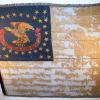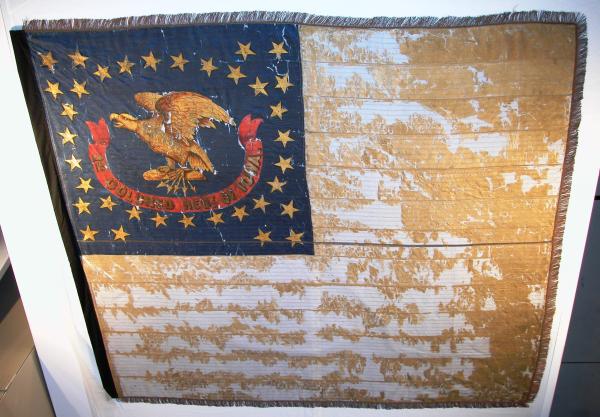Civil War & Slavery: Iowa
| Grade | 9th -12th Grades | Class | Length of Lesson | 90 minutes |
| Lesson Title | Civil War & Slavery: Iowa |
| Unit Title | |
| Unit Compelling Question | How did African Americans impact early US History, specifically the Civil War? |
| Historical Context: This flag, in the collection of the State Historical Society of Iowa, was used by the the 1st Colored Regiment of Iowa during the Civil War. Alexander Clark, a resident of Muscatine, Iowa, helped organize this regiment. When the Civil War began, Clark helped to recruit the "60th Iowa Colored Troops" also known as the Iowa 1st Infantry. By the end of the war, nearly 1,000 African-American from Iowa and Missouri had served. Clark himself enlisted when he was 37, and was appointed as sergeant-major but could not fight due to a physical defect in his ankle. Alexander Clark was born free in Pennsylvania in 1826 and moved to Muscatine from Cincinnati at the age of 16 to work as a barber. Once settled, he opened a business selling firewood to Mississippi River steamboats and thereby amassed considerable wealth. He also became an entrepreneur in local real estate. In 1850, he helped to organize the African Methodist Episcopal church in Muscatine and served as an officer there for 25 years. In 1865, he helped organize the Grand Lodge of Missouri, Prince Hall Masons, and served as Grand Master. Later, in 1884, he organized the Hiram Grand Lodge in Iowa and also served as Grand Master. In 1868, Clark was appointed chairman of a "colored mans" committee to rewrite the Iowa State constitution, eliminating the word "white" from the document, and thereby granting political equality to Iowans two years before the ratification of the Fifteenth Amendment to the United States Constitution. Clark is notable in Iowa history for other things, too. He sued the Muscatine school board on behalf of his daughter, Susan, in a landmark case that outlawed school segregation in Iowa. His son, Alexander Jr., became the first black graduate of the University of Iowa law school in 1879. Alexander Sr. became the second black graduate of the law school in 1884 at the age of 58. Clark was also active in Republican politics and was called "the Colored Orator of the West" for his speeches on the right of suffrage. In 1890, President Benjamin Harrison offered Clark the opportunity to become the first United States ambassador to the nation of Liberia at an annual salary of $4,000. Clark died of fever in Liberia in 1891. ~ Teaching Iowa History Team ### Race and policy in Iowa 1839-1876 Iowa's attitudes towards race underwent a radical transformation between its admission to the Union in 1846 to the end of Reconstruction in 1876. Iowa went from one of the most racist and prejudiced states in the North to one that seemed to embrace egalitarianism. The change was the result of advocacy by white reformers and pressure from African Americans who used the courts and political action to demand equal rights under the law. In Iowa, the earliest white settlers came from states where slavery was legal. They controlled the legislature where they passed laws, called Black Codes, that denied African Americans the right to vote, jury duty, and access to public schools. For a time it was illegal for blacks to enter the state. At the same time Congress passed the Fugitive Slave Act in 1850 which allowed bounty hunters to enter Iowa in search of runaway slaves. In 1857 pro-slavery advocates successfully defeated a statewide referendum to extend voting rights to black men. In the 1850s the abolition movement began to take hold. The territorial Supreme Court Case of Ralph in 1839 allowed that a slave who entered a free state had a right to his freedom. In 1843 an Anti-Slavery Society was organized by Quakers and other denominations. They participated in the Underground Railroad and aided John Brown as he recruited support on his way to Kansas. Iowa abolitionists abandoned the Free Soil Party to flock to the new Republican Party that sought to limit the expansion of slavery into Iowa and oppose secession. When the Civil War broke out, over 80,000 Iowans volunteered to fight to preserve the Union in face of the Confederate secession that endangered the nation. Letters and reports from Iowa troops described the horrible condition of African Americans in the South under slavery. This encouraged Iowans to follow the leadership of Abraham Lincoln and the Republicans in calling for emancipation. African Americans in Iowa played an important role in the war. In 1863 Alexander Clark, Muscatine businessman and African American leader, organized the 60th Iowa Colored Infantry Regiment which drew volunteers from Iowa and Missouri. Their military service was mostly in Arkansas where they saw some combat and displayed bravery in action, but mostly the 60th Iowa defended river ports. After the war, the African American community turned to the courts to demand the rights they had fought for. Clark successfully sued to have his daughter accepted in public school and Emma Coger won a lawsuit against a riverboat company that denied her access to public transportation. The most important initiative was the public referendum that removed the word white from the state constitution, giving black men the right to vote. This reform, one of the first of its kind in the nation and enacted before the federal 15th amendment, gave Iowa the name "Bright Radical Star" for its progressive racial policies. But while these actions transformed the legal structure, they did not necessarily change the personal prejudices and segregationist attitudes that many Iowans continued to practice. |
|
| Lesson Supporting Question | |
| Lesson Overview | This lesson is incorporated into a Slavery/Civil War Unit. It is designed to be taught after lessons on American slavery. It focuses on the Civil War in Iowa, particularly African American soldiers involvement. |
| Primary Sources Used |
|
| Resources Needed |
|
| Standard | |
| Lesson Target | Students will understand that slavery was a major influencer of the Civil War.;Students will understand that northern states were free and southern states had slavery.;Students will understand that southern states left the union (secession).;Students will understand that some states that stayed in the union were slave states. ;Students will understand that African Americans in Iowa (northern free state) were soldiers in the Civil War. |
| Lesson Themes | African American Experience, Civil War |
|
| Formative Assessment (How will you use the formative assessments to monitor and inform instruction?) |
Self assessment: exit ticket- 3 things you learned today. |
| Summative Assessment (How does the lesson connect to planned summative assessment(s)?) |
Performance Task: ½ Page Journal Entry, prompt- answer the essential question |
| Author | Patricia Brandt | Created | Last Edited | ||||
| Reviewer: Dr. Lisa Millsaps, University of Northern Iowa | |||||||
| Lesson Plan Development Notes: Teaching Methods, University of Northern Iowa, Fall 2018 | |||||||


